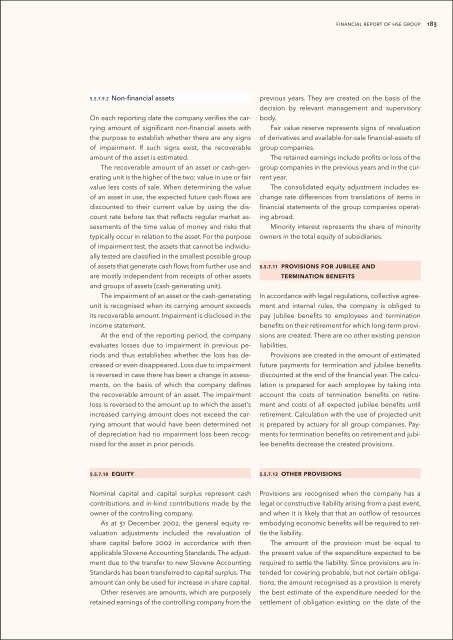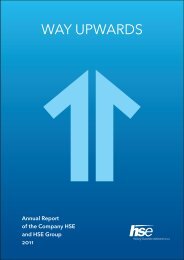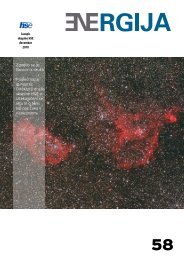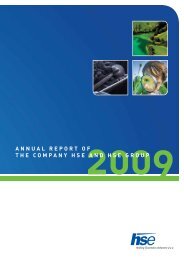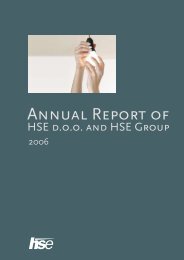WAY UPWARDS - HSE
WAY UPWARDS - HSE
WAY UPWARDS - HSE
You also want an ePaper? Increase the reach of your titles
YUMPU automatically turns print PDFs into web optimized ePapers that Google loves.
Financial report of <strong>HSE</strong> Group<br />
183<br />
5.5.7.9.2 Non-financial assets<br />
On each reporting date the company verifies the carrying<br />
amount of significant non-financial assets with<br />
the purpose to establish whether there are any signs<br />
of impairment. If such signs exist, the recoverable<br />
amount of the asset is estimated.<br />
The recoverable amount of an asset or cash-generating<br />
unit is the higher of the two: value in use or fair<br />
value less costs of sale. When determining the value<br />
of an asset in use, the expected future cash flows are<br />
discounted to their current value by using the discount<br />
rate before tax that reflects regular market assessments<br />
of the time value of money and risks that<br />
typically occur in relation to the asset. For the purpose<br />
of impairment test, the assets that cannot be individually<br />
tested are classified in the smallest possible group<br />
of assets that generate cash flows from further use and<br />
are mostly independent from receipts of other assets<br />
and groups of assets (cash-generating unit).<br />
The impairment of an asset or the cash-generating<br />
unit is recognised when its carrying amount exceeds<br />
its recoverable amount. Impairment is disclosed in the<br />
income statement.<br />
At the end of the reporting period, the company<br />
evaluates losses due to impairment in previous periods<br />
and thus establishes whether the loss has decreased<br />
or even disappeared. Loss due to impairment<br />
is reversed in case there has been a change in assessments,<br />
on the basis of which the company defines<br />
the recoverable amount of an asset. The impairment<br />
loss is reversed to the amount up to which the asset’s<br />
increased carrying amount does not exceed the carrying<br />
amount that would have been determined net<br />
of depreciation had no impairment loss been recognised<br />
for the asset in prior periods.<br />
previous years. They are created on the basis of the<br />
decision by relevant management and supervisory<br />
body.<br />
Fair value reserve represents signs of revaluation<br />
of derivatives and available-for-sale financial-assets of<br />
group companies.<br />
The retained earnings include profits or loss of the<br />
group companies in the previous years and in the current<br />
year.<br />
The consolidated equity adjustment includes exchange<br />
rate differences from translations of items in<br />
financial statements of the group companies operating<br />
abroad.<br />
Minority interest represents the share of minority<br />
owners in the total equity of subsidiaries.<br />
5.5.7.11 Provisions for jubilee and<br />
termination benefits<br />
In accordance with legal regulations, collective agreement<br />
and internal rules, the company is obliged to<br />
pay jubilee benefits to employees and termination<br />
benefits on their retirement for which long-term provisions<br />
are created. There are no other existing pension<br />
liabilities.<br />
Provisions are created in the amount of estimated<br />
future payments for termination and jubilee benefits<br />
discounted at the end of the financial year. The calculation<br />
is prepared for each employee by taking into<br />
account the costs of termination benefits on retirement<br />
and costs of all expected jubilee benefits until<br />
retirement. Calculation with the use of projected unit<br />
is prepared by actuary for all group companies. Payments<br />
for termination benefits on retirement and jubilee<br />
benefits decrease the created provisions.<br />
5.5.7.10 Equity<br />
5.5.7.12 Other provisions<br />
Nominal capital and capital surplus represent cash<br />
contributions and in-kind contributions made by the<br />
owner of the controlling company.<br />
As at 31 December 2002, the general equity revaluation<br />
adjustments included the revaluation of<br />
share capital before 2002 in accordance with then<br />
applicable Slovene Accounting Standards. The adjustment<br />
due to the transfer to new Slovene Accounting<br />
Standards has been transferred to capital surplus. The<br />
amount can only be used for increase in share capital.<br />
Other reserves are amounts, which are purposely<br />
retained earnings of the controlling company from the<br />
Provisions are recognised when the company has a<br />
legal or constructive liability arising from a past event,<br />
and when it is likely that that an outflow of resources<br />
embodying economic benefits will be required to settle<br />
the liability.<br />
The amount of the provision must be equal to<br />
the present value of the expenditure expected to be<br />
required to settle the liability. Since provisions are intended<br />
for covering probable, but not certain obligations,<br />
the amount recognised as a provision is merely<br />
the best estimate of the expenditure needed for the<br />
settlement of obligation existing on the date of the


